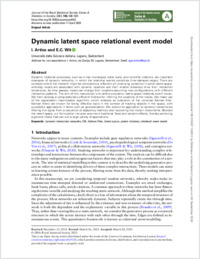Dynamic latent space relational event model
- Artico, Igor Facoltà di scienze informatiche, Università della Svizzera italiana, Svizzera
- Wit, Ernst C. ORCID Institute of Computing (CI), Facoltà di scienze informatiche, Università della Svizzera italiana, Svizzera
- 2023
Published in:
- Journal of the Royal Statistical Society. Series A. Statistics in society. - 2023, vol. 186, p. 508–529
English
Dynamic relational processes, such as e-mail exchanges, bank loans, and scientific citations, are important examples of dynamic networks, in which the relational events constitute time-stamped edges. There are contexts where the network might be considered a reflection of underlying dynamics in some latent space, whereby nodes are associated with dynamic locations and their relative distances drive their interaction tendencies. As time passes, nodes can change their locations assuming new configurations, with different interaction patterns. The aim of this manuscript is to define a dynamic latent space relational event model. We then develop a computationally efficient method for inferring the locations of the nodes. We make use of the expectation maximization algorithm, which embeds an extension of the universal Kalman filter. Kalman filters are known for being effective tools in the context of tracking objects in the space, with successful applications in fields such as geolocalization. We extend its application to dynamic networks by filtering the signal from a sequence of adjacency matrices and recovering the hidden movements. Besides the latent space, our formulation includes also more traditional fixed and random effects, thereby achieving a general model that can suit a large variety of applications.
- Collections
- Language
-
- English
- Classification
- Computer science and technology
- License
- Open access status
- hybrid
- Identifiers
-
- DOI 10.1093/jrsssa/qnad042
- ARK ark:/12658/srd1330206
- Persistent URL
- https://n2t.net/ark:/12658/srd1330206
Statistics
Document views: 49
File downloads:
- Artico_2023_OUP_Royal Stat Soc A_Dynamic latent space: 67
